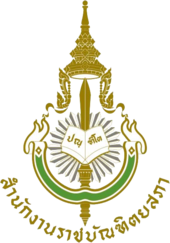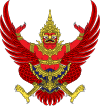Royal Society of Thailand

| ราชบัณฑิตยสภา | |
 | |
| Agency overview | |
|---|---|
| Preceding agencies |
|
| Type | Government agency |
| Jurisdiction | Nationwide |
| Headquarters | Sanam Sueapa, Dusit, Bangkok, Thailand |
| Annual budget | ฿151,991,400 (FY2024)[1] |
| Agency executive |
|
| Parent agency | Office of the Prime Minister |
| Key document |
|
| Website | www |
The Royal Society (Thai: ราชบัณฑิตยสภา; RTGS: Ratchabandittayasapha; pronounced [râːt.t͡ɕʰā.bān.dìt.tā.já(ʔ).sā.pʰāː]) is the national academy of Thailand responsible for academic works of the Thai government.
The secretariat of the society is the Office of the Royal Society (Thai: สำนักงานราชบัณฑิตยสภา; RTGS: Samnakngan Ratchabandittayasapha), formerly known as the Royal Institute (Thai: ราชบัณฑิตยสถาน;RTGS: Ratchabandittayasathan). The office is an independent agency of the government, but subject to the supervision of the prime minister.[2]
Members of the society consist of associate fellows, fellows, and honorary fellows. The associate fellows are academicians selected and appointed by the society. The fellows are associate fellows selected by the society and appointed by the monarch upon advice of the prime minister. The honorary fellows are prominent academicians selected by the society and appointed in the same way as the fellows.[3]
The society is known for its roles in the planning and regulation of the Thai language, as well as its many publications, particularly the Royal Institute Dictionary, the official and prescriptive dictionary of the Thai language, and the Royal Thai General System of Transcription, the official system for romanisation of Thai.
History[edit]
Founded as Royal Society[edit]
The Royal Society was established on 19 April 1926 by King Prajadhipok by combining the various existing agencies in charge of national libraries, national museums, literature works, engineering works, historical sites, and historical objects into one and the same agency for the reason that "Siam should have a learned society as in Western countries".[4]
The king named the society in Thai as Ratchabanditthayasapha (literally, "Society of Royal Pandits") after Krom Ratchabandit (literally, "Department of Royal Pandits"), an ancient government department in the Ministry of Public Instruction.[4]
Reorgnised into Royal Institute[edit]
After the Siamese revolution of 1932, the People's Party which carried out the revolution reorganised the Royal Society at the initiative of one of its members, Pridi Banomyong, by dissolving the Royal Society and splitting the works of the dissolved society into two new agencies, the Royal Institute and the Fine Arts Department, on 31 March 1934.[5]
The reasons for the reorganisation were stated by Luang Wichitwathakan, the first secretary general of the Royal Institute, as follows: "Our Royal Society had been in place since 2469 BE but it had not been structured to be what it should be. Instead of making the Royal Society a place for academic works like the present Royal Institute, the members of the Royal Society were loaded with administrative works, causing them to waste most of their time doing administrative works and have a little time for doing academic works. In addition, there had been no law or any other regulation requiring members of the Royal Society to do academic works."[5]
The reorganisation was designed after the Institut de France, dividing the Royal Institute into three academies: the Academy of Moral and Political Sciences, the Academy of Sciences, and the Academy of Arts,[5] which structure has been retained until the present.
The Royal Institute was first convened on 16 June 1934, presided over by Phraya Phahonphonphayuhasena, the first prime minister of Siam who addressed the convention as follows: "Our Royal Institute is not a tool or device for promoting the dignity of any particular person, but it shall be for honouring the Nation and the constitutional administration. If there should be a name that should stay together with the Royal Institute, that shall not be the name of a person, but the name of the House of Representatives, the name of the Constitution. If there should be anything that people of later generation should think of together with the Royal Institute, that shall be the Constitution."[5] At this convention, Prince Wan Waithayakon, Phra Riamwiratchaphak, and Luang Wichitwathakan were elected as the first president, vice president, and secretary general of the institute, respectively.[5]
The prominent works of the institute in the initial period include the revision of the official dictionary of Thai words, a work transferred from the Ministry of Public Instruction, as well as the production of Thai encyclopedias and gazetteers, the coinage of academic terms, and the creation of rules for romanisation of Thai.[2]
Renamed back to Royal Society[edit]
In 2013, the Council of the Royal Institute found it appropriate to honour King Prajadhipok on the occasion of the 120th anniversary of his birthday in 2015, by renaming the Royal Institute back to the Royal Society. To that effect, a law was introduced to and passed by the military-appointed National Legislative Assembly, which became the Royal Society Act, 2558 BE, effective on and from 14 February 2015.[3] In addition to the renaming, the act turned the Council of the Royal Institute into the Royal Society itself and turned the Royal Institute into the secretariat of the society, called Office of the Royal Society. The act also increased the powers of the society, such as by authorising it to confer degrees and certificates, to establish a welfare fund for its members, and to retain income for its internal use without having to send the income to the finance ministry as national revenue.[3]
Many members of the society objected to the renaming because of lack of public hearing on the matter.[6]
Headquarters[edit]
The society was first housed by Bang Khun Phrom Palace and later moved to the Vajiravudh Library on Na Phra That Road until 1988, when it moved to Ratchawanlop Building within the Grand Palace.[2] In 2006, the society moved to its present location at Sanam Sueapa near the Royal Plaza in Bangkok.[2]
- Former headquarters of the Royal Society within the Grand Palace, Bangkok
- Present headquarters of the Royal Society at Sanam Sueapa, Bangkok
Administration[edit]
For administrative purposes, the society has four divisions:
- Secretariat General
- Moral and Political Sciences Division
- Science Division
- Arts Division
The society's website states that each division has a staff of civil servants and clerical employees who perform both business and academic functions facilitating the works of fellows and associate fellows as well as conducting and promoting various academic activities.
Members[edit]
Scholars from the academic community of Thailand can apply for memberships in the society. Acceptance is based on applicants' contributions and published works. The levels of memberships in the society are:
- Honorary fellows
- Fellows
- Associate fellows
Of these, only the associate fellow titles can be applied for. Fellows are appointed by the monarch, chosen from amongst the existing associate fellows. Honorary fellows are likewise appointed by the monarch and are chosen from among scholars who are not already fellows of the society. These three groups can be collectively referred to as the members of the society.
Academies[edit]
Members of the society are divided into three academies. Each academy is subdivided into branches, and each branch includes several specific fields, totalling to 137 different academic disciplines.
Academy of Moral and Political Sciences[edit]
Academy of Science[edit]
Academy of Arts[edit]
|
|
Seal[edit]
The official seal of the society is a shining sword behind an open book bearing a Pali word, paṇḍito ("pandit"). A crown floats upon the sword and a ribbon bearing the name of the society is below the book.[7]
The sword and the book is based upon a saying, "wisdom is on a par with weapon" (Thai: ปัญญาประดุจดังอาวุธ). The light of the sword represents the light of wisdom. The crown represents the monarch.[7]
Works[edit]
Royal Institute Dictionary[edit]
Perhaps the most well-known work of the society is the prescriptive Royal Institute Dictionary.
The society has published four fully revised editions of the dictionary, and many intermittent reprintings with minor revisions. Each of the major revisions is associated with a significant year in Thai history, although in the case of the 1999 and 2011 editions, the actual publication date is a later year.
Spelling guidelines[edit]
The society also publishes guidelines for spelling of loanwords in Thai. A proposed change in 2012 met public criticism as Thai words borrowed from English were generally spelt without tone marks and the change would add tone marks to them.[8][9] Professor Kanchana Naksakul, senior fellow of the society who proposed the change, believed that the change would better reflect the actual pronunciation of the words and would assist foreigners in learning Thai.[9] Despite the support of around 300 survey respondents who were from linguistic circles[8][9] and the support of the Thai education ministry and higher education lecturers,[10] the change was voted against by the Council of the Royal Society on 17 December 2012.[11]
Royal Thai General System of Transcription[edit]
The society publishes the Royal Thai General System of Transcription,[12] the official way of romanisation of Thai.
References[edit]
- ^ "พระราชบัญญัติงบประมาณรายจ่ายประจำปี พ.ศ. ๒๕๖๗" (PDF). ราชกิจจานุเบกษา (in Thai). 141 (24A): 114. 26 April 2024.
- ^ a b c d e "ประวัติความเป็นมา". Office of the Royal Society (in Thai). 2020.
- ^ a b c Khemthong, Butsara (2015). "ราชบัณฑิตยสภา". parliament.go.th (in Thai).
- ^ a b "กำเนิดราชบัณฑิตยสภา". King Prajadhipok's Institute (in Thai). 2016.
- ^ a b c d e ""ราชบัณฑิตยสถาน" มรดกคณะราษฎร ก่อตั้งหลังเปลี่ยนแปลงการปกครอง 2475". Arts and Culture Magazine (in Thai). 24 June 2024.
- ^ "ยื่น สนช. ค้านเปลี่ยนชื่อ "ราชบัณฑิตยสถาน"". Post Today (in Thai). 28 October 2014. Archived from the original on 19 April 2015. Retrieved 16 April 2015.
- ^ a b Royal Institute of Thailand (2007). "Khrueang mai ratchakan khong Ratchabandittayasathan" เครื่องหมายราชการของราชบัณฑิตยสถาน [Official symbol of the Royal Institute] (in Thai). Bangkok: Royal Institute of Thailand. Archived from the original on 16 February 2015. Retrieved 16 February 2015.
- ^ a b "Royal Institute announces new spellings of 176 words". The Nation. 1 October 2012. Retrieved 1 October 2012.
- ^ a b c เปิด 176 คำทับศัพท์ภาษาอังกฤษ เตรียมแก้ให้ตรงเสียง เห็นแล้วจะอึ้ง!! [See new spellings of 176 words borrowed from English and you'll get voiceless!!] (in Thai). Prachachat. 30 September 2012. Retrieved 1 October 2012.
- ^ 'ครูลิลลี่' ห่วงคนใช้สับสน 'ศัพท์ลูกครึ่ง' 176 คำศัพท์จากราชบัณฑิต [Kru Lilly's concern: users will get confused in using 176 borrowed words respelled by the Royal Institute] (in Thai). Prachachat. 1 October 2012. Retrieved 1 October 2012.
- ^ ราชบัณฑิตล้มคำยืมจากภาษาอังกฤษ หลังผลไม่เห็นด้วย 178 เสียง [178 of Royal Institute Senators voted against the proposal to respell the words borrowed from English] (in Thai). Prachachat Online. 17 December 2012. Retrieved 17 December 2012.
- ^ Royal Thai General System of Transcription (RTGS)
External links[edit]
- Official website (in Thai)


